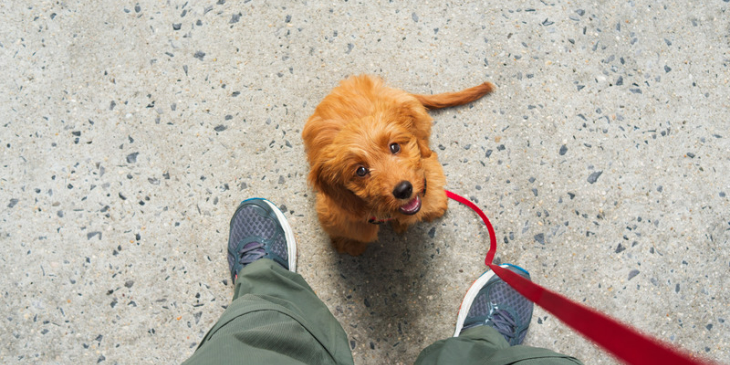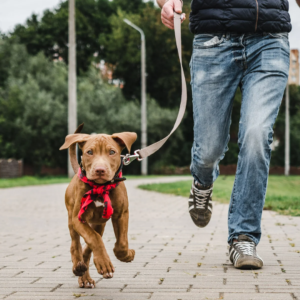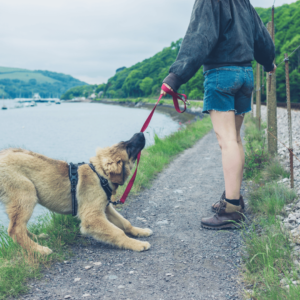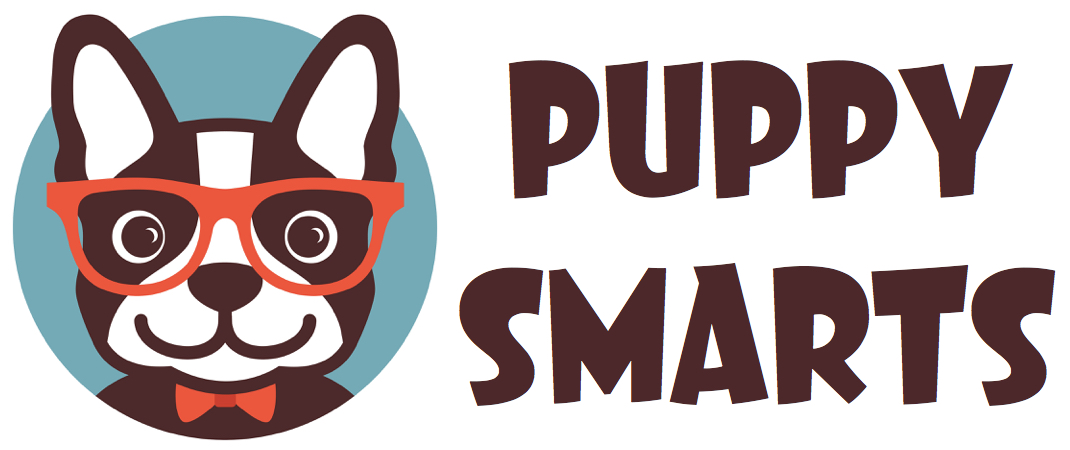How to Leash Train Your Puppy Step-By-Step

Contents
Welcome to the challenging (and sometimes frustrating) world of puppy leash training! If you’re a new puppy parent, you may wonder where to start when getting your new puppy used to walking on a leash.
Leash training is an essential part of puppyhood, not only for your puppy’s safety but also for bonding and socialization. In this blog post, we’ll break down how to leash train your puppy into simple step-by-step instructions.
From choosing the right leash and harness to overcoming common leash training challenges, we’ve got you covered. Whether you’re a first-time puppy parent or just need a refresher on the basics, this guide will help you and your puppy navigate the leash training process with ease!
When to Start Leash Training Your Puppy
The best time to start leash training your puppy is around 8-12 weeks old. At this age, puppies are more receptive to new training, and they’re just getting started with housetraining. Combining leash training with potty training is convenient, and it will help to prevent bad habits from forming.
Remember that young puppies aren’t fully vaccinated yet, so they shouldn’t be around other dogs. You can start to familiarize your puppy with the leash and harness in your home and yard, but hold off on walks around the neighborhood until your vet gives the green light.
Of course, young puppies are still developing self-control and focus, too. You’ll want to start slowly in controlled areas and keep training sessions very short. You want this to be a fun experience for your puppy, so reinforce good behavior and ignore the mistakes.
If you’ve adopted an older puppy or even an adult dog, it’s never too late to start leash training. But remember that it may take a bit more time and patience if bad habits like pulling or lunging on the leash are already formed.
Preparing for Leash Training
Before you begin the leash training process, it’s important to have the right equipment and establish a training schedule. Here are a few things to keep in mind as you prepare to leash train your puppy.
Choosing the Right Leash and Harness
The type of leash and harness you choose for your puppy can make a big difference in the success of your training. A six-foot leash made of lightweight material is the best choice for puppies who are just learning, as it allows them some freedom to explore, but not too much.
Avoid using retractable leashes, as they will give your puppy too much freedom and make it difficult to maintain control. They can also be difficult for puppies to understand and lead to confusion during the leash training process.
It’s best to opt for a harness over a collar during leash training. The harness should fit snuggly but not be too tight. You should be able to fit two fingers between the harness and your puppy’s neck and chest.
Establishing a Training Schedule
Puppies thrive on consistency, so establishing a training schedule is key for success when it comes to leash training. Choose a time of day when your puppy is most alert and set aside a few minutes each day so you won’t be rushed. Stick to the schedule as closely as possible, so your puppy learns what to expect.
Try a dog training app if you need help planning your sessions. It’s also important to know that leash training is an ongoing process. Even after your puppy has learned the basics, remember to practice walking on a leash regularly and reinforce good behavior to ensure your puppy stays on the right track.
Setting Up a Positive Reinforcement System
Positive reinforcement is a powerful training tool that encourages your puppy to repeat behaviors you want to see more often. Treats, praise, and play are all great forms of positive reinforcement. Most importantly, remember to stay patient and positive and keep things fun!

Positive reinforcement is a powerful training tool that encourages your puppy to repeat behaviors you want to see more often.
How to Leash Train Your Puppy Step-By-Step
Now that you’ve prepared for leash training, you’re ready to get started. Here’s a step-by-step guide to set you and your puppy up for leash training success.
Step 1: Introducing Your Puppy to the Harness and Leash
Before putting the harness and leash on your puppy, let him sniff and investigate them while you offer praise and reassurance. Then, put the harness on your puppy and let him wear it around the house for short periods, offering lots of positive reinforcement until your puppy becomes accustomed to wearing it.
Step 2: Teaching Your Puppy to Follow You While Wearing the Leash and Harness
Now that your puppy is comfortable wearing his harness, attach the leash and hold the other end. Slowly walk backward, encouraging your puppy to follow you with treats and praise. Gradually increase the number of steps you take as your puppy catches on to the idea.
Step 3: Progressing to Short Walks Around Your Home and Yard
Once your puppy becomes comfortable following you on the leash, you’re ready to start introducing him to short walks around the house and yard. Start with just a few minutes at a time, gradually increasing the duration of the walks as your puppy becomes more comfortable. Don’t forget to reward your puppy with lots of positive reinforcement!
Step 4: Gradually Increasing the Distance and Difficulty of the Walks
As your puppy becomes more comfortable with short walks, start gradually increasing the distance and difficulty of the walks. Slowly get him used to walking in new areas with more distractions and going for longer walks.
Step 5: Introduce Your Puppy to Some Basic Commands While on the Leash
Introduce your puppy to some essential basic commands, such as “heel,” “sit,” and “stay,” while on the leash. This is important for keeping your puppy safe and making walking more enjoyable.
- Heel Command: Teaching your puppy to walk next to you in the heel position is essential for maintaining control on a walk. Start by walking your puppy in a quiet area. Give the command “heel” and use a treat to coax him into the heel position. Practice these steps until your puppy walks next to you without a treat.
- Sit Command: Teaching your puppy to sit on the leash is essential when you need to wait before crossing the street, allow another dog to pass, or simply want to stop and talk to someone. To teach your puppy the “sit” command, hold a treat right above your puppy’s nose and move it back to coax him into the sit position. Use the command “sit” as you move the treat and give it to the puppy as soon as he’s in the correct position. Practice until your puppy sits on command while on the leash.
- Stay Command: Once your puppy knows how to sit while on the leash, he’s ready to learn the “stay” command. Stay is essential for your safety and his before crossing the street or at any time when you want him to remain at your side. Start walking with your puppy, and ask him to sit when you stop. Then give him the command “stay” and offer treats and praise after just a few moments. Gradually increase the time you expect your puppy to stay and practice until he no longer needs the treat to remain in the “stay” position.
Teaching your puppy to respond to these commands while on the leash can take time and patience, but it’s well worth the effort for his safety and yours. Remember to reward good behavior with treats and praise and always use a positive approach.
Step 6: Socializing Your Puppy with Other Dogs and People While on the Leash
One of the most critical aspects of leash training your puppy is socializing with other dogs and people while on the leash. This is key for curbing anxiety and keeping him calm when you’re out for your daily walks. Gradually expose your puppy to various new environments, people, and other pets, while reinforcing his training with treats and praise.
With these steps, you and your puppy will be well on your way to successful leash training. With time, practice, and lots of positive reinforcement, leash training your puppy can be a fun and enjoyable experience for both of you.
Overcoming Common Leash Training Challenges

Leash training can be a fun and rewarding experience for you and your puppy, but it’s not without its challenges. Here are a few common issues you may encounter during the leash training process and how to overcome them.
Pulling on the Leash
Pulling on the leash is a common issue when leash training a puppy. Try using a front-clip harness, which attaches the leash to the front of the puppy’s chest rather than between the shoulder blades. This helps steer the puppy in the right direction. When your puppy pulls, wait for him to stop pulling before continuing. Don’t yank or jerk on the leash, and don’t drag your puppy along with you.
Chewing on the Harness and Leash
As you’re probably well aware, puppy’s have a natural tendency to chew on things, and the leash and harness are no exception. To address this, start by using a chew-resistant harness and leash. Then redirect your puppy’s attention with a chew toy until he gets used to wearing his harness and leash without chewing on them.
Distractions During Leash Training
Puppies are just like toddlers and can be easily distracted by their surroundings. This can make leash training difficult. The best way to address this is to find a quiet area with minimal distractions and gradually introduce distractions as your puppy learns what’s expected of him.
Lack of Interest
Sometimes it’s hard to hold a puppy’s interest during leash training. To address this, keep training sessions short and make the process more interesting by keeping things fun and interactive. Treats, praise, and play are the best way to keep your puppy’s interest.
Leash Training is an Important Part of Puppyhood
Congratulations on taking the first steps toward leash training your puppy! Leash training is integral to puppyhood and will help ensure your puppy is well-behaved and safe anytime you leave the house.
Remember that being connected to a leash and going where we go doesn’t come naturally to a puppy. Walking on a leash is a skill that has to be taught. Although leash training requires time and patience, with the right approach, it can be a fun experience for both of you.
But don’t hesitate to seek professional help if you encounter issues you can’t overcome on your own. Puppy classes are a great place to get some extra support for you and some safe socialization for your puppy!
